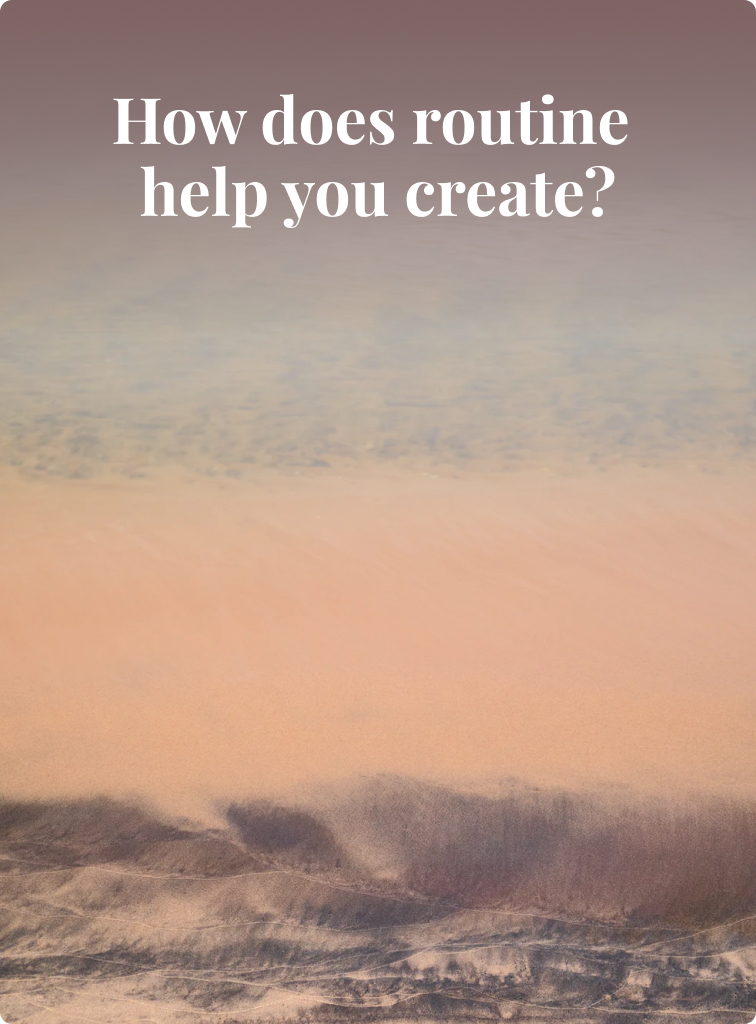Table of Content
As you know, creativity saves us from routine. Can routine, in turn, foster creativity
Routine is an automatic execution of commonplace tasks and following patterns. As a rule, it’s accompanied by a lack of worries, emotions and thoughts, and requires a minimum of expended effort.
Having a daily routine is more important than it may seem. For example, our anxiety reduces as habits bring predictability into our lives. It doesn’t matter what’s going on around you, but you know that in the morning you always work out and drink a cup of coffee. In an ever-changing world, rituals are essential. Habits allow us to accomplish our day-to-day tasks automatically. It unloads our minds.
The myth of the incompatibility between routine and creativity
There is a popular belief that some people are born more talented than others. It’s an excuse for your own stagnation: I don’t create because I’m not gifted. In fact, everyone can develop professional qualities. The most sparkling creativity is the result of good habits and hard work.
If it seems to you that your creativity flow doesn’t tolerate any restrictions and routine kills your creativity, it’s not entirely true. Cognitive psychologist Ronald T. Kellogg believes that rituals, on the contrary, increase creativity.
What are some creativity habits?
It’s very effective to build an optimal environment around you before starting a creative process. Every time before you get down to work, follow a few simple steps. These habits will help you set the mood.
Adjust the sound
The most common noise level is medium. Loud music clogs your brain and doesn’t allow you to concentrate on anything. Silence (or very low noise levels), on the other hand, draws too much attention to different things and hinders your creative process.
Choose the right temperature
According to research by Cornell University, when temperatures are below 20°С, employees make 44% more mistakes than at an optimal room temperature of 25° С. You have to waste energy to keep yourself warm, it distracts from the work process and negatively affects creative thinking. You should also be careful with high room temperatures, since they’re even more detrimental. The ideal choice is + 25° С.
Choose lighting
Dim lighting helps us calm and relax: we experience less fear and are ready to take risks. Darkness allows you to act more confidently. Lightning level in the workspace should be adapted to specific tasks and the creative process intensity. If you need to focus on a routine task, make the lighting brighter. And if you have to generate the most extraordinary ideas, you can turn off the light at all.
Set up your workplace
Psychologist Bob Boyce recommends identifying a place where the author can concentrate on serious things, eliminate all non-essential sources of information, and minimize social contacts. The space should be created only for writing and thinking. Then it’ll connect with the author’s product of thought and improve the working process.
However, a cluttered desk can still stimulate creativity. A study published in the journal Psychological Science in 2013 shows that working in a messy environment helps people bring out their creativity. In any case, it’s advisable to turn off or put away smartphones. Intrusive notifications ruin your concentration.
However, a cluttered desk can still stimulate creativity. A study published in the journal Psychological Science in 2013 shows that working in a messy environment helps people bring out their creativity. In any case, it’s advisable to turn off or put away smartphones. Intrusive notifications ruin your concentration
Creativity as routine
There is a widespread vision of the artist as a free, undisciplined human being who creates in a flash of inspiration and not according to a schedule. But inspiration can become another habit.
Treat creativity as a ritual and do it regularly. Once you have enough time and a right place for it, you’ll start getting into a creative flow more often. It’ll be a safe space for your imagination, and you won’t need to wait for the arrival of the muse anymore.
Many creators like the final result more than the process. A good result is always a thorny path of hard work, trial and error. You can try to avoid failures if you only do what you are good at. It’ll lead to stagnation in personal development and burnout. Mistakes are proof of professional competence. It’s a sign that you’re trying new things and finding yourself.
In the meantime, while new habits are being formed, let’s just pause and give our minds a moment to think about what’s happening. Composer Allen Sean, who suffered from agoraphobia (agoraphobia is a fear of open space, open doors and a fear of being in a crowded area where unexpected actions might be needed), wrote in his memoirs: “Our habits help us adapt to the strangeness of the world”. Learn more about the unpredictability of our world in the article about Adaptive thinking.
